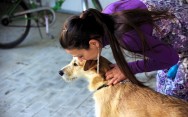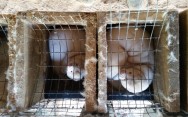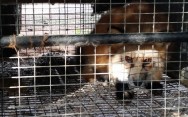Blog Archives
Home -
Posts tagged "Transhumanism"
As Morocco prepares to host the 2030 FIFA World Cup, there have been reports of mass culling of
stray dogs in an effort to “clean the streets” before the tournament. A collective of ten animal rights
organizations, including Eurogroup For Animals and Four Paws, has written to FIFA, urging the
organization to take a stand against this horrific slaughter. Morocco had previously committed to a
humane dog population management strategy through a ‘Trap, Neuter, Vaccinate, Release’ (TNVR)
program, yet reports suggest that authorities are instead resorting to killing stray dogs in violation of
their own policies and with wanton cruelty.
The Moroccan government has justified these actions under the pretext of controlling rabies, a fatal
disease transmitted through bites. This contradicts the scientific evidence and the government’s
prior commitment to sustainable measures such as TVNR, which are proven to be more effective as
well as being humane. The open letter from animal rights groups calls on FIFA to use its influence to
hold Morocco accountable for its commitments and ensure that dog population management is
ethical, upholds previous commitments and does not sacrifice animal lives.
The situation raises urgent ethical questions about humanity’s treatment of animals that do not
serve our self-interested purposes. Stray dogs, often dismissed as nuisances, are living beings
deserving of dignity and compassion. Their existence in our cities is not their fault but rather a
consequence of human neglect and mismanagement. To kill them for the sake of a sporting event
reflects a disturbing willingness to sacrifice lives for aesthetics and convenience. As a global
institution with immense influence, FIFA has a responsibility to take a stand against cruelty and
support humane solutions.
With five years to go before the tournament, Morocco has the opportunity to stick to ethical and
sustainable measures to care for their stray dog population rather than wantonly killing them. FIFA
must use its platform to pressure the government from preventing a catastrophic mass killing,
ensuring that the World Cup is not tainted by the horrific suffering of animals that are discarded as if
their lives had no meaning. The world is watching, and now is the time to demand a humane
approach that values animal lives as equally.
The Moroccan dog “genocide” must be stopped. Sign the petition to tell FIFA that they must us their
pressure to stop these catastrophic mass killings: https://actionnetwork.org/petitions/the-
international-animal-coalition-is-calling-on-fifa-to-demand-morocco-stop-killing-dogs-for-the-world-
cup
For more on our educational and advocacy programs on behalf of animals, please visit our website:
https://www.freedom4animals.com/
|
Tags: Animal Freedom,
Animal Genocide,
Animal Massacre,
animal rights,
FIFA,
Kevin Boileau,
Morocco,
Nazarita Goldhammer,
Rabies,
Stray Dogs,
TNVR,
Transhumanism,
World Cup
On December 2, 2025, Mexico made a historic leap forward for animal rights by amending its
Constitution to include protections for nonhuman animals. This reform is the first of its kind in the
nation. While many countries have animal protection laws, few have elevated the protection of
animals to constitutional status, and even fewer have extended this to cover all species, including
farmed animals. Mexico’s new constitutional changes mark a groundbreaking shift towards treating
animals as beings deserving of legal recognition and rights, regardless of their species.
In most countries, animal welfare laws are selective, often prioritizing companion animals over those
in agricultural industries. In the United States, for example, farmed animals are often excluded from
protections that apply to pets or wildlife. Mexico’s reforms aim to change that by ensuring all
animals, from farmed animals to those kept as pets, are entitled to legal protection. This
approach could set an example for other nations, particularly in Latin America, where animal rights
movements are gaining momentum. However, with Mexico being one of the world’s top producers
of meat and animal products, it is highly probably that economic interests will hinder the
implementation of these reforms. Agricultural lobbyists could easily push back against these laws to try to
protect profits.
One particularly important aspect of the reforms that could have a positive impact on the future is
education. The changes require the inclusion of animal welfare education in Mexican schools. In the
best-case scenario this could influence a new generation that values and understands animal rights.
It could be the first step in changing cultural attitudes towards animals on a larger scale. While the
specific details of this educational shift have yet to be defined, the hope is that it will lead to a
transformation in how Mexican society views and treats animals in the future.
The constitutional amendment represents a step forward in recognizing animals as sentient beings
with rights, but the true test will be in the details. It is unlikely that Mexico will go far enough in
creating strong, enforceable laws that truly afford equal protection to animals. On the other hand,
this victory sends a message about the direction society is capable of going if social imagination can
conceive of animals as equal beings to humans. There are many self-interested forces at work trying
to convince humans that it is too difficult to value animals in parity to ourselves, that there are too
many problems or steps to be taken, and true equality for animals is not possible. Legislation at a
constitutional level proves that changes can be far-reaching and can affect all animals.
At Freedom 4 Animals, our work includes both education and advocacy. Both of these things
contribute to change, as people learn about our fellow inhabitants of this earth and how we can
elevate their status as beings worthy of equal consideration. Please read more about our work to
educate the public and fight for animal freedom.
Peanut the Squirrel and Fred the Raccoon were two beloved rescue animals who were euthanized after a raid on their owners’ home by the New York State Department of Environmental Conservation (NYSDEC).
Who is responsible for their deaths? The party directly responsible is the NYSDEC who carried out the raid and the Chemung Health Department (CCHD) Environmental Health Services who ordered the animals euthanized to test for rabies. More generally however, there’s a need to reckon with our collective responsibility for the way human regulations can affect animals’ lives.
Peanut, (otherwise known as P’nut), was a baby squirrel rescued by Mark Longo after his mother was hit and killed by a car. Longo bottle fed and cared for the baby squirrel. Longo says he tried to release Peanut back into the wild but Peanut had become attached to his human carers and returned to their house with a damaged tail. After that, Peanut became a family member. Mark Longo later started an animal rescue shelter and adopted Fred the Raccoon, who was also a victim of the raid.
The raid was a response to complaints about Longo’s animal rescue center and his illegal ownership of P’nut and Fred. It is illegal in New York to keep wild animals as pets. Only licensed wildlife rehabilitators can rescue animals, and only wild animals registered as educational animals can be kept as pets. Mark Longo said he was in the process of filing the paperwork to apply for a wildlife rehabilitation license and to register Peanut and Fred as educational animals. He indicated that the process was slow and he needed more guidance from the DEC.
The paperwork involved in registering for these official designations is burdensome, and many wildlife lovers may not be informed about how to care for animals that they rescue from the wild.
Peanut and Fred were euthanized on the authority of the CCHD because of rabies concerns. Even though squirrels aren’t known for carrying rabies, Peanut’s proximity to Fred the raccoon (racoons are known to carry rabies) prompted the euthanization of both animals after Peanut bit through the gloves of someone carrying out the raid. Both animals were found to be free of rabies.
Animal and human interactions happen frequently. All animals are known to interact with each other in nature. Yet animals are in danger of being euthanized every time they take a perfectly logical step of seeking food from human property, or of allowing a human to take care of them when they are in need.
What started with the death of Peanut’s mother due to human causes (the car that hit her) ended with the death of Peanut because of human laws that are indifferent to animal needs and behaviors. In both cases, human standards and technology are imposed on animals and encroach in animal environments. Animals who get in the way become the victims.
There are many examples of animals taking care of other animals in the wild, particularly baby animals. When humans do the same there is little understanding for this process. There should be a protocol to help humans care for animals that are wounded or sick, or to raise babies who can no longer survive in the wild. Right now, the protocols have no room for understanding that animal-human interaction does happen naturally, and that animals should not suffer as a result.
Animals are frequently euthanized due to the threat of rabies. Their heads are cut off to examine their brains. Rabies is a deadly disease and animals are euthanized out of an excess of caution, but so often these tragic and violent deaths are a result of inadequate protocols and clumsy investigations surrounding animals that get close to humans. There is currently no ante mortem test for rabies for animals.
Like so many stories about animal deaths, the death of Peanut the squirrel and Fred the Raccoon is a story about human indifference to animals, and indifference to the roles they play in our lives. It is natural for humans to interact with animals. We are animals too, after all.
Animal control laws involve brutality and a lack of nuance. Just like with human first responders, animal first responders often react with violence. Instead of social workers humans get the police who arrive with guns. Instead of care and due process, animals are sent to their death just because they get close to humans.
Violence is a direct result of a lack of care for the individuals involved in the situation and the specifics of each person and each life, whether human or animal. The first response to animals who choose to live with humans should not be violence. There needs to be a slower more responsive process that cares for everyone involved.
|
Tags: Animal Conflict,
Animal Euthanasia,
Animal Law,
Animal Lives,
animal rights,
Freedom for Animals,
Human Animal Conflict,
Kevin Boileau,
Nazarita Goldhammer,
Peanut the Squirrel,
Rabies,
Raccoon,
Rescue Animal,
Squirrel,
Transhumanism,
Wild Animals
It’s not just humans who use medicines or are drawn to wild plants to cure ailments. Animals are
known to self-medicate when they are ill, wounded or for stress and sadness. This
phenomenon, known as Zoopharmacognosy, has been observed in many species of animals. It
reveals how animals interact with their environment in a way people have written off as
exclusive to human science and medicine.
One common example is when dogs and cats eat grass to induce vomiting. There are many
other examples of animals using medicine in sophisticated ways. For example, apes have been
observed isolating the medicinal parts of plants by tearing off leaves and stems and taking them
internally or applying the pant to their wounds. Research in lambs has shown that animals can
learn to use medicine by observing the effects of certain plant foods. Animals eat plants to expel
parasites, get nutrients missing from their diets, and induce labor, among other things.
An Indonesian male orangutan named Rakus was observed applying plant sap and crushed
leaves to a wound on the “flange” surrounding his face, as a poultice. The plant, known locally
as akar kuning (Fibraurea tinctoria), is an Asian plant known for its antibacterial, antifungal, anti-
inflammatory and pain relief properties. Rakus was applying plant medication externally for
healing in the same manner that humans used this traditional medicine.
Andrea DiGiorgio, a biological anthropologist at Princeton University, noted that animals don’t
need to understand everything about the medicinal properties of a plant to be able to utilize the
resources in their environment in an intelligent way. DiGiorgio said: “I think this really speaks to
the intelligence that all animals have to utilize what works for them.”
Humans assume that the taxonomy of human knowledge accumulated through language and
writing gives us superior intelligence and understanding of our environment, but this speaks to
the advantages of human technological development rather than intelligence itself. This is
called Speciesism; and carries with the idea that humans are at the top of the hierarchy and
have the greater moral value.
Animal intelligence is rich and in tune with its environment. Often humans are looking in the
wrong places when they search for animal intelligence and knowledge, basing it on concepts of
intelligence that have been imposed by human and Western perspectives. If we observe
animals in their environment, we can see what we have missed. Animals often lead humans to
medicinal plants, water and shelter. Their remarkable senses and intelligence are not
meaningless tools that assist human technology, they should be respected in their own right.
A solar eclipse is a temporary, but dramatic event that humans historically have striven to
understand, whether they arrived at mystical, religious or scientific conclusions. Humans, however,
are not the only animals to react to an eclipse of the sun. So far there have not been extensive
studies of what animals do when confronted by a solar eclipse, but scientific research emerging out
of the April 8 th eclipse might reveal how animals react to a total eclipse of the sun.
The results so far suggest that animals react in a number of different ways. The current
understanding also reveals how animals are sensitive in ways that humans may not be. Animals are
like humans in many ways, and one of these ways is that all animals are different, and have different
capabilities, heightened senses and social understandings of their environment.
For example, Jane Goodall observed chimpanzees pointing at a solar eclipse and screaming. Baboons
were observed increasing their grooming behavior, which is often associated with a stress response.
Other research observed animals launching into nighttime behaviors as if it was time to sleep.
Overall, animal behavior was diverse across different species, as some birds began singing new
songs, some spiders began weaving a different kind of web or breaking their webs, and many other
behaviors were observed that may have meaning only to the animals. Many animals displayed
anxiety and some animals, such as bears, were indifferent. Galapagos turtles began attempting to
breed during the eclipse.
Animal sensitivity could cause certain reactions in animals, to changes caused by the eclipse.
Photosynthesis drops during an eclipse, and charged particles in the atmosphere can cause heat
fluctuations and solar winds. Animals sensitive to oxygen, C02, temperature and wind could be more
acutely aware of an eclipse.
One thing that animal reactions teach us is that animals are not a block – they are many different
species of beings that share the earth with us and react differently to various stimuli.
A number of projects have begun researching animals’ response to the recent solar eclipse, and
they have invited the public to share their research findings from the eclipse. All animal research
should be conducted humanely and without harm or stress caused to the animals. Please support
research projects and gather research that does not harm animals. https://youtu.be/-fkgb4yBUuk?si=gYjpncxlNX-w3lmm
South Korea’s dogmeat trade has long been a national source of shame, especially to younger
people, who have developed more progressive views about animals. Pets such as domestic dogs and
cats have become more popular, changing people’s views of dogs as disposable animals that can
be farmed for meat. The dogmeat trade has been dying out on its own, but it has lingered on. The
dog meat trade is incredibly cruel and dogs are often killed in extremely painful ways. Dogs are kept
caged and suffer cruel conditions where they see other dogs killed. As social animals, this must be
unbearable to them.
Last year, South Korea’s parliament voted near unanimously to ban the dog meat industry. The law
takes effect in 2027 and will ban any future slaughter breeding and sale of dogs for dog meat.
The consumption of dog meat is based on historical traditions and unscientific beliefs about the
health benefits of dog meat. One of the most horrifying things about these traditions is that dogs are
deliberately tortured before death because of the belief that the adrenaline levels in the animal will
contribute to health benefits. Although dog meat was traditionally eaten in South Korea in the past,
there is evidence that this was not widespread and it became more popular due to false beliefs
about its effects on virility in older men. Animals have long been tortured because of human crazes
and the dog meat industry is a particularly cruel example. Not only are animals farmed for dog meat
but also abandoned pets are collected from the streets and slaughtered for the dog meat trade.
Activists inside and outside of the countries where dog meat is eaten have protested the practice.
On the other hand, condemning the practice has been associated with anti-Asian racism in incidents
in the US where restaurants have been falsely accused of selling dog meat. Consuming dog meat is
not “barbaric” because of a country’s culture, it is barbaric because humans are capable of extreme
cruelty towards animals when it is in their own interests.
Although it’s positive that dogs will be protected from this horrific cruelty in the future, the dog
meat ban should not draw attention away from the suffering of all animals such as cows, which in
Western culture are slaughtered for meat while in Korean culture traditionally were not killed and
kept as work animals. Animal rights activists and philosophers have argued against “speciesism,” in
which some animals are considered more deserving of safety than others. Banning dog meat is a
reflection of the public’s increasing intolerance of cruelty toward animals that are kept as pets.
Ultimately we must fight for animal rights to be extended beyond pets and towards all animals.
|
Tags: Animal Breeding,
Animal Cruelty,
animal rights,
Animal Suffering,
Cruelty to Dogs,
Dogmeat Industry,
Kevin Boileau,
Nazarita Goldhammer,
Speciesism,
Transhumanism,
Vegan
It’s no secret that the meat industry is trying hard to improve its image. As research continues to demonstrate the impact of meat and milk on greenhouse gas emissions, lobbyists for the livestock industry have been working to develop a counter-offensive.
The Protein Pact was launched in July 2021 and consists of mostly U.S. based livestock industry firms. The National Pork Producers Council is one of these groups, which challenged California’s Prop 12 before the Supreme Court and lost. The council’s president made headlines recently when he said he wouldn’t comply with even the modest animal welfare requirements of California law.
Chances are, you might have noticed a significant backlash against plant-based proteins and “fake meat” in the last year. There are strong indications that the meat industry has positioned influencers, dietitians and other messengers to influence public opinion on the benefits of meat. The Protein Pact organization works with Red Flag Consulting which is known for its efforts to interfere with climate policy action in the EU.
The group has also funded academic research to promote their claims. U.C. Davis’s CLEAR center, is funded in part by pact partner IFeeder and has been the subject of multiple investigative news stories, including one published in the New York Times, about its misleading communication efforts. Other controversial figures like Richard Berman are named in articles about the backlash against vegan meat. The Berman PR company has been involved in defending industries such as big tobacco.
“Big meat” has an image problem that can’t be whitewashed. It revolves around the cruel treatment of animals in industrial farms, as well as the harm the industry causes the planet. The industrial production of meat and exploitation of animals makes up 15% of global emissions and 60% of food production emissions. It’s no surprise that moves away from big meat and towards plant protein would be met with attempts to stifle these efforts.
It’s important to remember that influencers make their money from paid sponsorships and so-called candid advice may be funded by less than above-board sources. Articles with knee-jerk titles that claim to debunk veganism and vegan protein could well be part of a backlash that is more about business interests than science. Vegans can help to combat this disinformation by carefully fact-checking and tracing the sources of articles sent my family and friends.
|
Tags: Animal Cruelty,
Animal Protein,
animal rights,
Industrial Farming,
Kevin Boileau,
Meat Industry,
Nazarita Goldhammer,
Plant Protein,
Protein Pact,
Transhumanism,
Vegan,
Vegan Meat,
Wellness Influencers
Spain’s new animal rights law has notable exceptions that teach us a lot about how people view animals.
Spain has made it illegal to leave pets alone. Wild animals have been banned from the circus and marine parks are not allowed to keep any new dolphins in captivity that haven’t already lived in the marine park for most of their lives. Pets can no longer be bought from pet-shops or online. Only licensed breeders can sell pets. Mandatory pet insurance and registration is also required.
One of the quirks of the law is that it leaves out certain animals that feature in cultural activities in Spain. Hunting dogs are excluded from the legislation after the hunting lobby fought for the exception. Bullfights are also left out of the legislation, despite being one of the cruelest sports involving animals.
Bullfighting involves stabbing a bull with lances to weaken the animal, then eventually killing the bull. The bull is led into the ring, greeted by a matador, then jabbed by picadors and usually killed by the matador. The “sport” consists of introducing an animal to an extremely stressful situation– a ring with a large cheering audience — baiting and disorienting the animal, wounding it, then killing it. It is an activity that animal rights activists have long fought against. It is losing favor with the public even in places like Spain where bullfighting is traditional. Leaving it out of a sweeping animal rights law is arbitrary and caters to humans, leaving animals to suffer.
The fact that these exceptions are left standing says a lot about how humans prioritize the beings who are worthy of dignity and protection. Working animals, lab animals or animals like invertebrates are often left out of animal rights laws. Animal protection is still a cultural exercise enacted by humans who feel a closer relationship with some animals than others due to tradition, culture and the extent to which humans recognize traits of themselves in the animal. Many of the provisions in Spain’s animal rights law have been welcomed by activists, but the law does not yet achieve the goal of animal rights, which is to treat animals as if they have equal rights to humans, and each other.
|
Tags: Animal Abuse,
Animal Cruelty,
Animal Equality,
Animal Neglect,
animal rights,
Animal Rights Law,
Bullfighting,
Hunting,
Kevin Boileau,
Pets,
Transhumanism,
Working Animals
If you are a vegan you have sworn off eating animal products or wearing any animal products such as leather. You may not be aware of the prevalence of animal derived materials in many other everyday products. So much of our industrial world is built off the back of profiting from the slaughter of animals, it’s difficult to keep track. While it’s impossible to completely eliminate everything sourced from animal products, it is possible to make an audit of what you use and eliminate everything possible. If you are aware of our dependence on animal products you can also advocate for a new innovative economy in which we leave behind our dependence on the products of animal suffering.
The following are 5 animal products that may be found in common materials you don’t expect:
- Gelatine. Gelatine is known as the ingredient that is found in jelly and jelly sweets. However it’s also used as a binder in matchheads, sandpaper and pill capsules. It is made by boiling the skin and hooves of animals to create a gel substance.
- Casein. Casein is a byproduct of the dairy industry. It is a protein found in most mammals’ milk. It’s surprising how many common uses it has, such as in paint, glue, plastics and in dentistry and tooth repair.
- Lanolin. Lanolin is a substance in the skin of sheep and other woolly animals that acts as waterproofing for their wool. It is used in many lotions, balms and skincreams. It can also be found in shoe polish, in rust proofing and as an industrial lubricant.
- Guanine. Guanine comes from fish scales and is used to give a pearlized sheen to shampoos, nail polishes and other cosmetic and personal hygiene products.
- Ambergris. Ambergris is made from whale intestines and it is a fixative used in perfumes and a flavoring in foods and beverages.
Animal products are unfortunately an integral part of our production and industrial supply chain. This means that many common products are obtained in cruel and inhuman ways. Although vegans may be disciplined about cutting out foods that come from animals, it’s easy to forget how many other products are sourced from animals.
As well as avoiding products with animal ingredients, it’s important to advocate for alternatives and challenge the existing system. When it comes to clothing there are many alternative materials such as cactus leather and other materials that are vegan friendly. Industrial products can be more tricky but many products, like paint, have vegan alternatives. More companies are manufacturing 100 percent vegan products by using vegan solvents, binders and other materials. As a vegan it’s important to advocate for vegan industrial products and spread the word or find ways to encourage innovation in your industry. The following is a more exhaustive list of vegan products from Peta: https://www.peta.org/living/food/animal-ingredients-list/
The rise in Orca boat attacks has been a big story in the news. People have been alarmed by reports of Orcas off the Iberian peninsula biting off the rudder of boats. The incidents been on the rise since they began to be recorded in 2020 in the Gibralter Strait. Why are Orcas doing this? Some people are blaming an aggrieved matriarch called White Gladis who had a traumatic experience with a fishing boat. Researchers have theorized that White Gladis is passing this grievance to young orcas and teaching them how to attack boats. The narrative has some people cheering on orcas for fighting back against humans, and other people making dire predictions about the grievance spreading among Orcas, causing Orcas to sink boats. There are quite a few problems with this theory. First of all, Orcas have the power to sink boats, but they are not sinking them. Instead they are playing with rudders and damaging the boats. Another big problem with the idea of Orca armies is that the Orcas of the Gibraltar Strait are threatened. The latest reports are that there are only 35 individuals left.
The attacks do look intentional, but some theories suggest that this is actually a learning exercise for young Orcas. It’s a way to practice hunting without depleting fish stocks. If Orcas can learn how to hunt by tracking boats that have a fin, like dolphins or other prey, they can hone their skills without depleting their food supply. The trend has spread among young Orcas, and young Orcas are known for mimicking each other and adopting trends, just like human teenagers.
The truth is, no one actually knows why Orcas are interacting aggressively with boats. It has been pointed out that there have been periods of sustained oppression by humans of orcas, such as during the 1960s and 70s when humans stole Orcas from their families to keep in amusement parks. Yet, in all this time, Orcas haven’t struck against humans. As with so many human assumptions about the motivation of “the other”, whether it is another group of human beings, or a group of animals going about their lives, the story about a vengeful matriarch seems designed to stoke enmity and outrage. As usual the answer to these questions is likely more complex than the human tendency to simplify things and make them into black and white questions of good and bad. The truth is Orcas, just like us, have lives to lead, and their behavior usually indicates the pressures of their everyday lives. Those lives and motivations may be obscure to us, but we must refrain from projecting motivations onto Orcas when we don’t understand their world. This failing has caused untold destruction among humans, and it has allowed us to inflict violence on the animal “other” with impunity.
The real story of the Orca attacks on the Iberian peninsula may be unclear, but one thing should be obvious. Like many other species, Orcas have had to fight to maintain their livelihoods under threat of human encroachment. If Orcas are approaching boats in a habitat crowded by humans, it shouldn’t be a surprise.
https://www.washingtonpost.com/opinions/2023/06/19/orca-attacks-sinking-boats-science/
|
Tags: Animal Culture,
animal rights,
Animal Sentience,
Cetaceans,
Endangered Animals,
Kevin Boileau,
Marine Life,
Nazarita Goldhammer,
Orca,
Orca Boat Attacks,
Transhumanism








Social Media